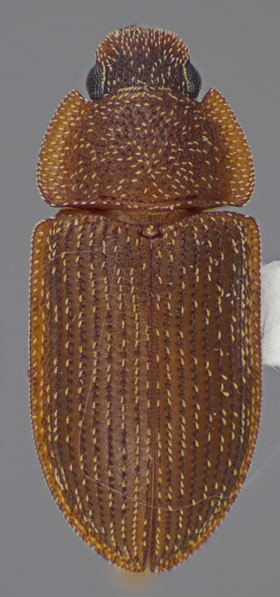 |
 Previous Genus Next Genus Previous Genus Next Genus 
Genus: Colobicus
Diagnostic Features
- Description: Body distinctly flattened. Antennae 11-segmented with a distinct, 2-segmented club. Antennal setation sparse. Antennomere 3 distinctly elongate (at least twice as long as 4). Subantennal grooves long, reaching posterior margin of eye. Eyes round, well-developed, facets fine. Pronotum simple, with flattened, short, recumbent setae. Pronotal lateral margins smooth, widest basally, distinctly explanate. Procoxal cavities narrowly open. Metacoxae narrowly separated, separation less than metacoxal length. Elytral lateral margins weakly explanate. Elytra with distinct striae composed flattened, short, recumbent setae. Tarsal formula 4-4-4.
- Similar genera: The genus Colobicus is superficially similar to the genera Acolobicus and Eucicones. The smaller size, presence of faint carinae on the pronotal disc, lack of thick, flattened, club-shaped setae and unicolored dorsal surface serve to distinguish Acolobicus. The smaller size, variegated elytra, rougher dorsal surface, and distinctly more setose vestiture serve to distinguish Eucicones.
Known Distribution
- Hawai'i, and Southeastern (LA) USA.
Biology
- Colobicus parilis has been found at UV/MV light and from under the bark of a number of trees. It has been noted that this species has been found on commercial shipments and in stores of sweet potatoes and other crops, where it is suspected to spread fungal disease (Hinton, 1945; Ivie, 2002). Due to the destruction of crops from fungal disease spread by this beetle, it should be considered harmful.
- Abundance: Rare.
North American Species (1)
Discussion
- This genus is found throughout the Australo-Pacific region. It has likely been introduced into the United States, possibly on crop products.
Selected References
|
 |
 
Colobicus parilis
© N.P. Lord |
© 2011-2015 Lord, N.P., Nearns, E.H., and K.B. Miller
The University of New Mexico and Center for Plant Health Science and Technology, USDA, APHIS, PPQ.
|


